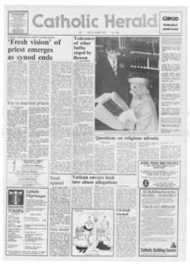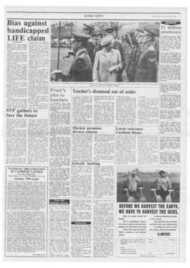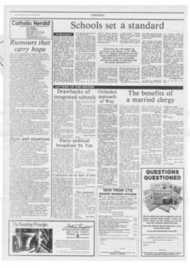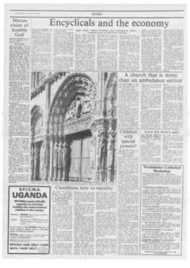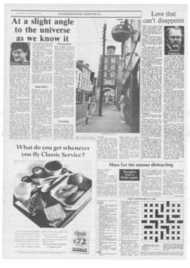Page 5, 26th October 1990
Page 5

Report an error
Noticed an error on this page?If you've noticed an error in this article please click here to report it.
Tags
Share
Related articles
Passion And Precision: Lord Reesmogg In Me And My God,...
Bending The Knee To Fashion
Church Furnishing Firms Merge B Ecause The Changes In...
The Experts On
Rebels With A Cause
Another side to fashion
In our series on "church" firms, Joanna Moorhead visits clerical outfitters Vanpoulles
FORGET the zippy minis and chiffon skirts we saw paraded on the catwalks last week. This year's strongest fashion statement, I can reveal, is the fully-tailored, coat-style alb. If you're still wandering around in one of those drawstring, roundnecked models, father, chuck it out. The coat-style version is here to stay.
Daring types will wear it on its own, perhaps with an embroidered stole to add a dash of colour: others will decide to top it with a rayon or a damask chasuble. As far as colours are concerned, you still can't go wrong with green, violet, red or white — though if you really want to make a splash, go for gold. And now could also be the time to dig out that ancient embroidered cope you'd hidden away at the back of the wardrobe: the news from the designers is that traditional gear could be making a comeback.
No, it's not the news from the London Style Fair but — you guessed it — this year's hot tips from the front-line of ecclesiastical fashion, Vanpoulles of Purley. Vanpoulles have been kitting out the British clergy for almost all this century and, says director Edwin Appleton, although it's probably not the most style-conscious sector of the rag trade, definite trends do come and go.
. Take those albs, for example. .You'd think that at just £19 each the drawstring ones would hold a certain attraction, even if they are known as the "sack of potatoes" variety. But they just don't shift, while the smart, coat-fronted ones are walking off the rails at £77 each.
It was back in 1908 that one Maurice Vanpoulle, owner of a company which sold vestments to priests in his native France and in Belgium, decided to test out the market in England. He opened a shop in Vauxhall in south London, taking on Laurence Appleton, Edwin's father, as a salesman. Business grew steadily over the following years and decades, allowing Vanpoulles to expand into new offices nearby.
By the outbreak of World War Two, Laurence Appleton was running the British end of the company, with Maurice Vanpoulle back in France. After his country, was invaded by the Nazis his profits had to be paid to the Custodian of Enemy Debts, but by the return of peace M Vanpoulle had died. Laurence Appleton, soon to be aided by his three sons Edwin, Laurence and Robert, bought out the Vanpoulle shares and took over the entire running of the firm.
The war years and their immediate aftermath brought hard times for Vanpoulles. "It was so difficult getting the right cloth, you see," explains Edwin Appleton. "We had to use anything we could get to make the vestments — women's dress material and even velvets . . . anything we could lay our hands on, really."
Conditions eased, and
business prospered, during the fifties and sixties, and in 1964 the company bought a new site at Wallington in Surrey and transferred its warehouse space out there. When, four years later, it became .clear that the cost of renewing the lease on the offices in Vauxhall would be prohibitively expensive, the obvious solution was to move out to the same area. So it was that, in 1973, Vanpoulles transferred to Purley, where it now occupies a large, shopfronted building beside the Brighton Road.
The window of the shop is
currently dominated by a seasonal crib: inside are shelves and cabinets crammed with the paraphernalia of Christian worship — silver chalices, stainless steel patens, glass cruets, embossed pyxes, gold ciboriums. Around the floor are large wooden statues, priests' chairs, lecterns, and tabernacles decorated with last supper scenes: a collection of baroquestyle censers hang against one wall.
The sale of these items accounts for a substantial portion of its £2 million annual turnover: but it is upstairs, in a room bright with garments of the liturgical colours, that Vanpoulles continues what has selling of vestments.
The vestments fall into two basic categories: the traditional style with their distinctive Y-cross front and back, and the rather looser, plainer postsixties styles embossed with minimalist logos of loaves and fishes, pax-crosses and grains of wheat, which retail with the help (or hindrance) of suitably ecclesiastical-sounding names such as "Vatican", "Cluny", and "Pascal". Damask is the usual cloth for the traditional chasubles, polyester mixes for the modern.
Since the end of World War Two, and especially since Vatican II, the trend has been away from the elaborate, heavy styles of old and towards the plainer robes, although, says Mr Appleton, the old-fashioned gear retains a loyal and sizeable following.
In the past, many of the vestments were painstakingly put together by nuns, but these days, with convent closures and new vistas for many religious, only a handful of seamstresssisters continue to sew. Much of Vanpoulles stock is therefore imported from Belgium, and the whole range is available by mail order through a catalogue illustrated with colour pictures ably photographed by Edwin Appleton, who happens to be fairly gifted with a camera.
Orders flood in from Australia, Africa and the United States as well as from all parts of the UK, and from Church of England as well as Catholic clients. Since the Anglicans admitted women to the rank of deacon and, in some parts of the world, to the priesthood, Vanpoulles have had a foray into the field of women's clerical dress, but it proved, by Mr Appleton's account, a bit of a disaster. "We had some blouses in and spent a lot of time and trouble designing fussy. They complained about where the tucks were and all sorts of things. So we thought, blow it, we won't bother."
Mr Appleton will not, one suspects, be campaigning for the women's ordination cause in the Catholic church. "I find women very troublesome myself," he finishes candidly.
blog comments powered by Disqus


